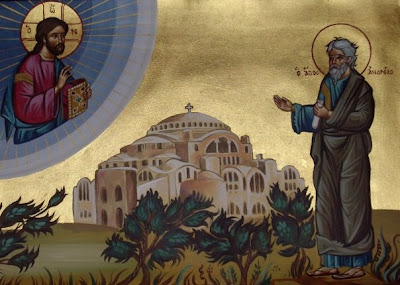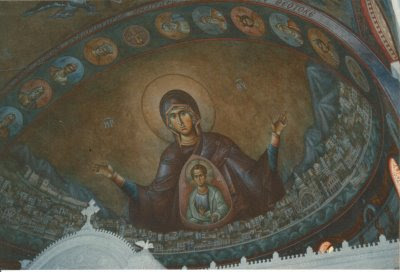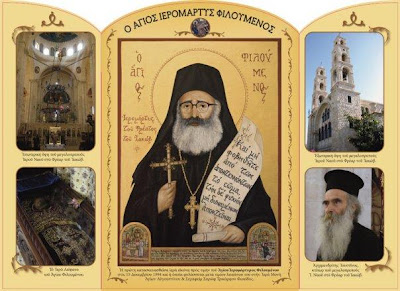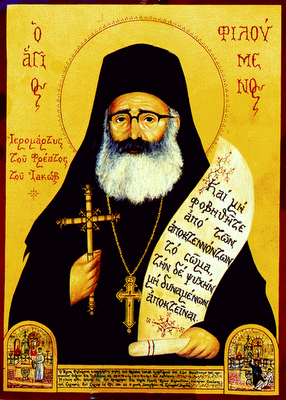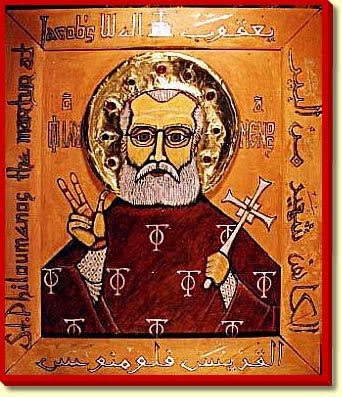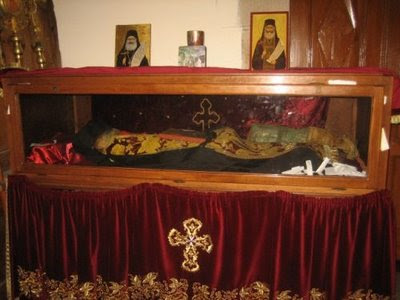 St. Antonie the Anchorite, otherwise known as St. Anthony the Hesychast (Feast Day - November 23)
St. Antonie the Anchorite, otherwise known as St. Anthony the Hesychast (Feast Day - November 23)
By Hieromonk Ioanichie Bălan
There are numerous Romanian hermits with a saintly life who lived throughout the centuries in the old forests and the hidden caves in the depth of the Carpathian Mountains. But, by the Lord’s grace, most of them remained unknown, loving more the peace and the life of a foreigner for the love of Christ, who sacrificed Himself on the cross for the redemption of man.
One of the great hermits of the Carpathians was the Righteous Antonie (Anthony) of Iezeru – Vâlcea Skete, called "Saint Antonie the Anchorite" by the locals. This righteous father is the most renowned hermit of Oltenia from the end of the 17th century and the beginning of the next. His name and his deeds remind us of Saint Daniil (Daniel) the Anchorite from Stephan the Great’s Putna Monastery in the 15th century.
The Righteous Antonie the Anchorite was born in one of the villages near the Carpathians of Vâlcea County. During his childhood he lived in purity. He had a great love for the monastic life and he often went visiting the numerous monasteries and sketes from that place, as well as the hermits who were searching for peace in the mountains. Then, following the advice of the igoumen of Iezerul - Vâlcea Skete, he took up the cross of Christ, becoming a monk in this far from the world skete. Here lived a few hermits who loved living in peace, prayer and fasting, who raised the young monk Antonie in his spiritual life by accustoming him to silence, fasts, night vigils, humbleness and especially incessant prayer.
After a few years the zealous hermit, advancing in spiritual life and having a great love for Christ, wanted to follow the hermits from long ago and retreat in the mountains to live in peace, to perfect his prayer and holy life. So he often visited the righteous that lived in the depth of the forests and requested their advice and blessing. Then, through a lot of prayer, fasting and all night vigils, and by running to the help of the Theotokos, the protector of Iezeru Skete, he received the blessing to retreat to live as a hermit, like many other monks wanted.
So, in 1690, the Righteous Antonie climbed a few miles to the mountain where the skete is. There he searched a cave for a small church and a cell. After a lot of searching and prayer, he found a small cave under a rock and started living in it. This was his cell, prayer corner, room and safe house for his body tired through fasting and
metania [repentance]. But his soul didn’t rest completely because there wasn’t any church nearby, where he could raise day and night his heart and hands in prayer. Then he prayed to the Theotokos and started digging a small church in the rock. And he worked alone for three years only with a chisel and a hammer. Then he added an iconostasis, icons and other things needed, and when it was ready, the Righteous Antonie called the Bishop of Râmnic, Ilarion (Hilarion), to bless it. In this small church dug in rock, the blessed elder prayed to God day and night for the rest of his life, together with the angels in Heaven.

But who can say anything about his ascetic life, the three days long or even longer fasts, the all night vigils, the struggles with the unseen enemies who can’t stand the humbleness and the labors of the saints, the fiery prayer and the unstopping tears that spring from the heart? He never slept for more than two or three hours at night and he didn’t eat anything else than old bread soaked in water and salt with a few vegetables that he grew in his small garden. Then he was repeating incessantly “The Jesus Prayer” from his heart and he was reading the Psalter, with a lot of tears of humility.
For his many deeds, the Righteous Antonie has received from God the gifts of foreseeing and of healing human sufferings. Anyone who came to his cave and asked for a word of advice and prayer received the fulfillment of his request. The Elder also had a few disciples in Iezeru Skete who came to him on holidays and brought to him his needed things. One of them was Father Nicolae Ierei, the one who knew the best the life of the Righteous Antonie. He is the one who buried the Elder after his repose and wrote his life.
By 1700, Iezeru Skete, built by King Mircea the Shepherd (1553), was deteriorated and the church deserted. From 1700 to 1705, at the urge of the Righteous Antonie the Anchorite, the bishop of Râmnicu-Vâlcea, Ilarion, together with the villagers of Cheia rebuilt the church out of stone, as well as the cells. We can read on the church’s inscription: “This holy church, where it is celebrated on the Entry of the Most Holy Mother of God into the Temple, was first built by the late king Mircea with his queen Chiajna, in 7061 (1553 AD), and after some time, because of carelessness, was deteriorated. And then it was rebuilt by the God-loving kir Ilarion, bishop, being helped by Antonie the schema monk…”.
Tradition says that this great anchorite contributed himself to the rebuilding of the church and the cells of Iezeru as he was from this skete and very zealous at rebuilding the house of the Lord, the one incessantly glorified by both men and angels. But not only then, but also many times the Righteous Antonie climbed down from his cave to Iezeru Skete, especially during the great holidays, to participate in the Divine Liturgy and take communion of the Flesh and Blood of Christ. Then, after he ate together with the brothers from the skete and gave useful spiritual counsels to his disciples, he climbed to his hidden cave in the mountains, in the depth of the forests. But he didn’t have disciples only in monasteries, but also people from the villages and cities, hearing about the holiness of his life, came to Iezeru Skete and to the cave to receive counsel and a prayer of blessing.
The name of the Righteous Antonie became known also over the Carpathians, even in the northern part of Transylvania, from where the believers came down the valleys of Jiu or Olt rivers to ask the Saint to pray for them or at least touch his clothes. One of these disciples was "the humble hieromonk kir Nicolae, son of Nicolae from Teiuş”, who came regularly to the cave of the Righteous Antonie. Upon hearing about this famous hermit, he left Transylvania and became a monk at Iezeru Skete, becoming the Saint’s closest disciple. At the Saint’s advice, he was ordained as a priest and spiritual father of the skete by bishop Ilarion of Râmnicu - Vâlcea and he sometimes celebrated the Divine Liturgy in the cave of the Righteous Antonie.

After 28 years of harsh acetic life as a hermit, the Righteous Antonie the Anchorite, pleasing the Lord, gave his soul into His hands, some time before 1714. His disciple, "the spiritual father Nicolae Ierei”, took care of the Saint during his last few days, giving him communion. Then, being wept over by his disciples – hermit monks and believers from everywhere -, he was buried by the igoumen of Iezeru Skete and all the monks near the door of the small church dug in the rock by hand, near the cave, where he still is.
Many years later his disciples – or even believers from the villages around – were climbing Iezeru Mountain with kollyva, oil and candles in their hands and, after they were praying in the small church, they were making
metanias [prostrations] and weeping at the tomb where the relics of the Righteous Antonie lie, whom they honored as a saint. Then they were holding a memorial service, lighting hundreds of candles and vigil lamps, were crossing themselves in the cave of Saint Antonie, where the good soldier of Christ lived for 28 years, suffering great temptations from the devils, and then they were climbing down the mountain, each one to his home, asking the help and prayers of their spiritual father. This tradition was kept until our times in those places, especially in Iezeru Skete, which he helped building.
Several years after the departure of the Righteous Antonie the Anchorite, his disciple, "Nicolae Ierei, the spiritual father”, wrote his life, as he was the one who knew it the best, in which he writes, among other things: "…(Schema Monk Antonie,) wanting to live alone, so he can fight against the artful one, and leaving the monastery and trying in deserted places and searching for a place to pray, by the Lord’s grace, he found this cave…”.
Today we can still see the righteous’ cell, called "The Cave of Saint Antonie” by the locals, as well as the little stone church, deserted. Near the door of this small church is the tomb of the Righteous Antonie the Anchorite with the forgotten relics of a Romanian saint who prays before the Holy Trinity for us all.
Source: The Patriarchate of the Romanian Orthodox Church, Romanian saints and defenders of the Law of our forefathers, E.I.B.M.B.O.R., Bucharest, 1987, p. 496-499. "The Righteous Antonie the Anchorite of Iezeru-Vâlcea".

Additional Notes: According to the nuns at the skete, he was a merchant of Vlach origin, born in Ioanina. He was married and had a son who became a priest. At 64 years old, he became a monk at Saracinesti Monastery, a few kilommeters away from Iezeru Skete. He wanted to go to Mount Athos, but bishop Ilarion sent him to rebuild Iezeru Skete. In 1690 the saint retreated in a small cave a few kilometers away from Iezeru, where he eventually was buried. Before he died he told his disciple Nicolae that they will stay in the skete as long as his relics are buried in the cave. In the 19th century, Saint Calinic of Cernica (April 11) wanted to search for the holy relics, but the night before he came, the rock collapsed and most of the tomb was covered. Saint Calinic realised it was the will of Saint Antonie to remain there so he gave up searching for the holy relics. Just recently, a part of his holy relics were uncovered and placed in the church of Iezeru Skete.
Saint Antonie of Iezeru was officially canonized in 1992. The article above by Elder Ioanichie Balan was written in 1987. He is commemorated on November 23rd.
Everything translated by Marius Nitu.

The cave of St. Antonie

The church built by St. Antonie













